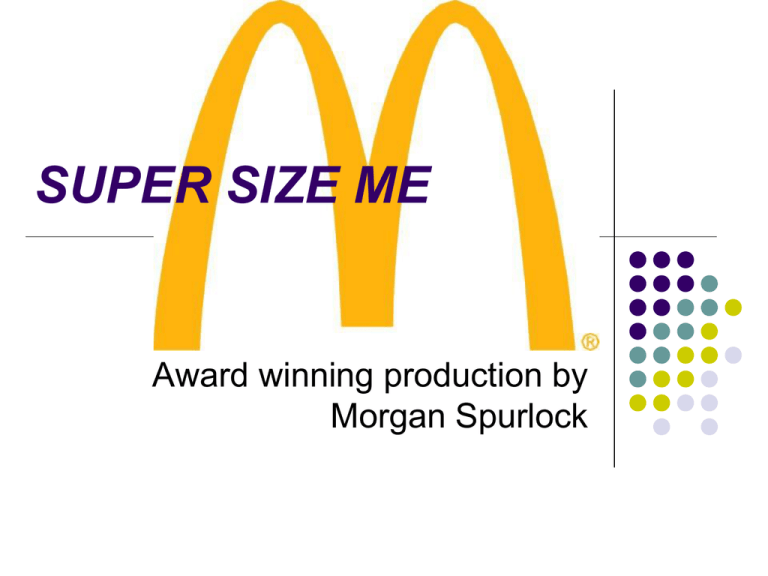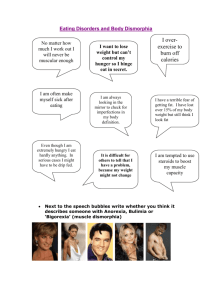Disordered Eating - Cherokee County Schools
advertisement

SUPER SIZE ME Award winning production by Morgan Spurlock VitaMINDS: Day 4 Summer. D.I.E.T. (Discipline In Eating Thing) Eat to live Don’t live to eat. You are what You eat! You are what You Ate! Eating Disorders: From Diet to Disorder to Disordered Eating Where does it all start? Let’s talk about Body Image… What is Body Image? The perception, imagination, emotions, and physical sensations of and about our bodies. About Body Image Sensitive to changes in mood, environment, and physical experience Psychological in nature Takes on positive and negative forms Influenced more by selfesteem than by actual physical attractiveness Some people with negative body image may develop disordered eating patterns. People with disordered eating patterns may: Engage in compulsive and excessive exercise Manipulate medications to lose weight Have a fear of certain foods Obsessively count calories, fat grams, and other nutrients Allow themselves to eat only organic, healthy foods Fear eating in public or with others Continually look for and follow the newest “fad diet” The Prevalence of Disordered Eating 1 in 5 women struggle with disordered eating Disordered eating is not simply a “female issue” Men Minority men and women 24 million Americans and 70 million people worldwide struggle 42 percent of 1st, 2nd, and 3rd grade girls wish to be thinner 2 out of 5 women and 1 out of 5 men would trade 3 – 5 years of their life to reach their “goal body weight” Those who diet are 5 TIMES more likely to develop an eating disorder… Anorexia Nervosa: the relentless pursuit of thinness and an attempt to maintain strict control over food intake. The defining features of this eating disorder are (a) an intense and irrational fear of body fat and weight gain, (b) an iron determination to become thinner and thinner, and (c) a misperception of body weight and shape to the extent that the person may feel or see "fat" even when emaciation is clear to others Anorexia Nervosa: These psychological characteristics contribute to drastic weight loss and defiant refusal to maintain a healthy weight for height and age. Food, calories, weight, and weight management dominate the person's life, and they become angry or defensive when someone tries to disrupt this private system. Person refuses to maintain normal body weight for age and height. Weighs 85% or less than what is expected for age and height. Is terrified of becoming fat. Person denies the dangers of low weight. Anorexia Nervosa: Is terrified of gaining weight even though she/he is markedly underweight. Reports feeling fat even when very thin. In women, loss of three consecutive menstrual periods. Young girls do not begin to menstruate at the appropriate age. In men, reduced libido. In addition to the above, anorexia nervosa often includes depression, irritability, withdrawal, and peculiar behaviors such as compulsive rituals, strange eating habits, and division of foods into "good/safe" and "bad/dangerous" categories. Anorexia and Bulimia may coexist. Anorexia and Bulimia may coexist. Many bulimia nervosa patients have a history of anorexia nervosa; others may subsequently lose weight and become anorexic. Approximately half of anorexia nervosa patients engage in binging and purging behaviors associated with bulimia. Bulimia Nervosa: Bulimia Nervosa: the diet-binge-purge disorder This eating disorder is characterized by selfperpetuating and self-defeating cycles of binge-eating and purging. During a "binge," the person consumes a large amount of food in a rapid, automatic, and helpless fashion. This may anesthetize hunger, anger, and other feelings, but it eventually creates physical discomfort and anxiety about weight gain. Thus, the person "purges" the food eaten, usually by inducing vomiting and by resorting to some combination of restrictive dieting, excessive exercising, laxatives, and diuretics. Bulimia Nervosa: As with anorexics, bulimics may have a distorted body image, an intense fear of fat, and the conviction that a slender body shape is absolutely crucial for self-acceptance. Person binge eats. Feels out of control while eating. Vomits, misuses laxatives, exercises, or fasts to get rid of the calories. Diets when not bingeing. Becomes hungry and binges again. Believes self-worth requires being thin. May shoplift, be promiscuous, and abuse alcohol, drugs, and credit cards. Weight may be normal or near normal unless anorexia is also present. Bulimia Nervosa: Like anorexia, bulimia can kill. Even though the person puts up a cheerful front, she/he is often depressed, lonely, ashamed, and empty inside. Friends of bulimics may describe them as competent and fun to be with, but underneath, where they hide their guilty secrets, they are hurting. Feeling unworthy, they have great difficulty talking about their feelings, which almost always include anxiety, depression, self-doubt, and deeply buried anger. Compulsive overeating is characterized primarily by periods of impulsive gorging or continuous eating. While there is no purging, there may be sporadic fasts or repetitive diets. Body weight may vary from normal to mild, moderate, or severe obesity. Compulsive overeating • • • • • The person binge eats frequently and repeatedly. Feels out of control and unable to stop eating during binges. May eat rapidly and secretly, or may snack and nibble all day long. Feels guilty and ashamed of binge eating. Has a history of diet failures. Compulsive overeating: Tends to be depressed and obese People who have binge eating disorder do not regularly vomit, over exercise, or abuse laxatives like bulimics do. They may be genetically predisposed to weigh more than the cultural ideal (which at present is exceedingly unrealistic), so they diet, make themselves hungry, and then binge in response to that hunger. Or they may eat for emotional reasons: to comfort themselves, avoid threatening situations, and numb emotional pain. Regardless of the reason, diet programs are not the answer. In fact, diets almost always make matters worse. Compulsive exercising : Compulsive exercising is not a recognized diagnosis as are anorexia, bulimia, and binge eating disorder. We include it here because many people who are preoccupied with food and weight, exercise compulsively in attempts to control weight. The real issues are not weight and performance excellence, but rather power, control, and self-respect. Compulsive exercising : • • • • The person repeatedly exercises beyond the requirements for good health. May be a fanatic about weight and diet. Steals time to exercise from work, school, and relationships. Focuses on challenge. Forgets that physical activity can be fun. Compulsive exercising : • • • • Defines self-worth in terms of performance. Is rarely or never satisfied with athletic achievements. Does not savor victory. Pushes on to the next challenge immediately. Justifies excessive behavior by defining self as a "special" elite athlete. Can You Tell? There is no certain ‘look’ to someone with disordered eating practices or negative body image. Images in the popular media do not account for everyone. In order to be sensitive to those with disordered eating habits or body image issues, it is crucial to know that ANYONE can struggle with these things! Things we can’t control… Genetic predisposition to eating disorders- If a immediate family members has been diagnosed with an eating disorder, studies show that individual is 4x more likely to develop one. Things we can’t control… Scientists are still researching possible biochemical or biological causes of eating disorders. In some individuals with eating disorders, certain chemicals in the brain that control hunger, appetite, and digestion have been found to be imbalanced. The exact meaning and implications of these imbalances remains under investigation. Things we can’t control… Psychological Factors that can Contribute to Eating Disorders: Low self-worth. Feelings of inadequacy or lack of control in life. Depression, anxiety, anger, or loneliness. Things we can CONTROL #1- MEDIA The average person sees between 400 – 600 ads per day, with one out of every 11 having a direct message about beauty. #2- What you say… “do I look fat?” Stop Diet Talk!!! #3Bust Diet Myths! Myth # 1: Fat is Bad. Fat is NECESSARY for the body to function properly. Fat should make up 25 percent of your daily caloric intake. Fat is an important energy source. Fat is imperative to maintain hormonal balance and regular menstrual cycles. #3Bust Diet Myths! Myth # 2: Low Carbohydrate Diets Work. The body needs carbohydrates, as they are the body’s main energy source and are stored in the muscles. Carbohydrates provide fiber, B vitamins, and iron. #3Bust Diet Myths! Myth # 3: Protein is Not Important. Protein is the building block of major organs. Protein is necessary to build and repair muscles. Enzymes and many hormones are made of protein. Protein is crucial to maintain hormonal balance and regular menstrual cycles. What Can YOU Do? Know How to Help Someone! Know the warning signs. Express your concern in a loving, non – threatening way. Choosing “good” and “bad” foods. Significant weight loss or weight gain. Excessive worry and talk of numbers, shape, and size. Use “I” statements. Avoid “You” statements. Avoid giving simple solutions. Do not comment on the person’s weight, size, or food rituals. Be firm and caring in what you are saying, without being mean. Tell someone else. Counselor. Parent. Teacher/Coach. What Can YOU Do? Know How to Keep Yourself Healthy! Do not weight yourself or count calories or fat grams in your food. Do not diet – this will only make you want and think about food more often. Listen to your body – it can tell you when you are hungry and full. Learn better ways to cope with feelings that lead you to over eat, under eat, and use other negative behaviors. Accept your body and appreciate it for allowing you to function. Do not compare yourself to others.





